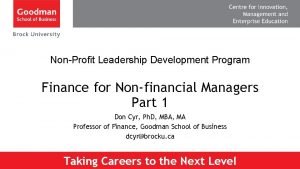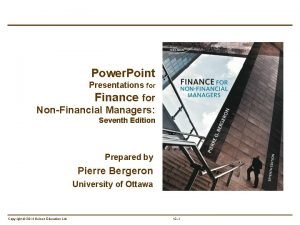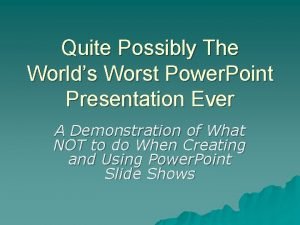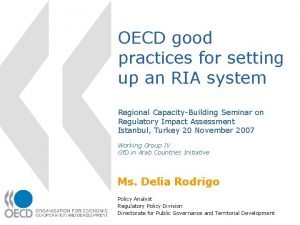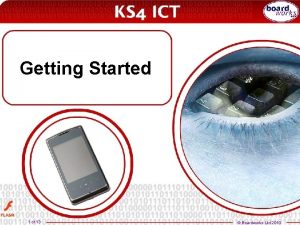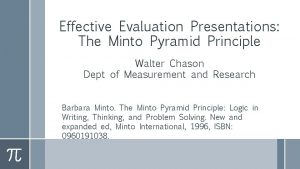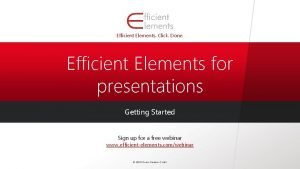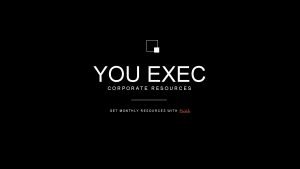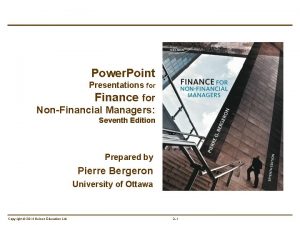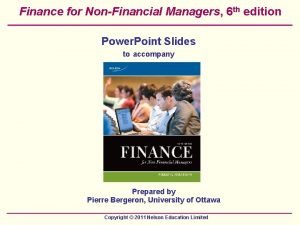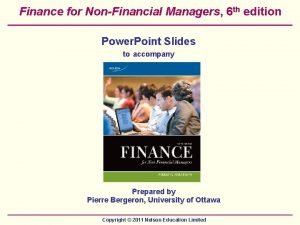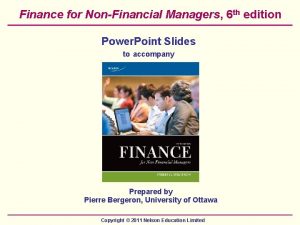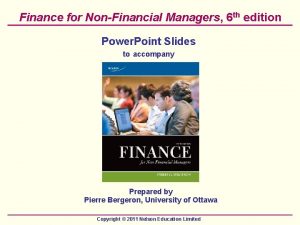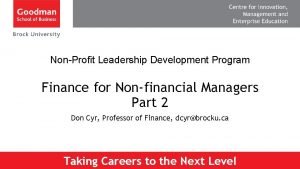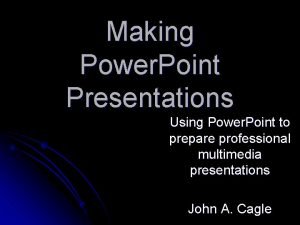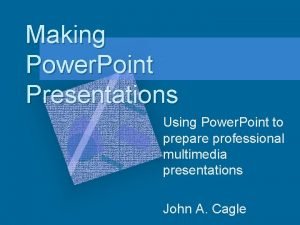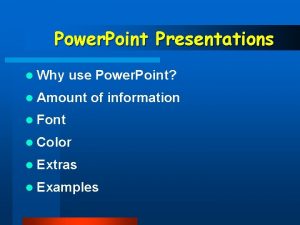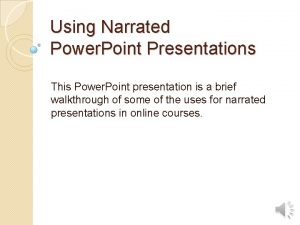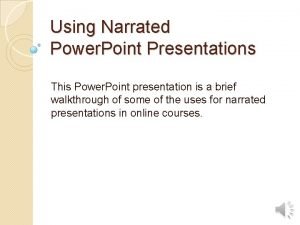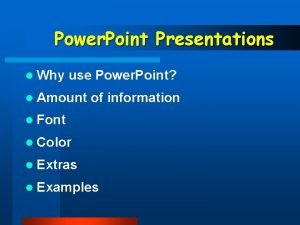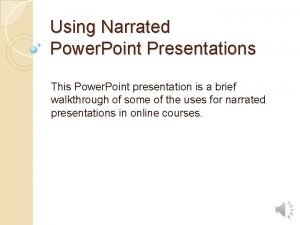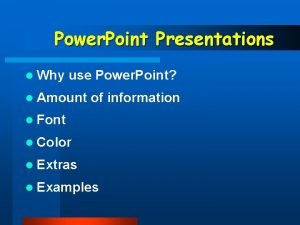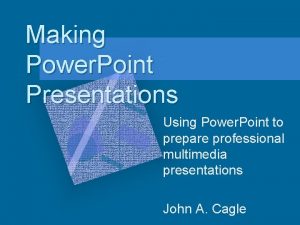Power Point Presentations for Finance for NonFinancial Managers

























- Slides: 25

Power. Point Presentations for Finance for Non-Financial Managers: Seventh Edition Prepared by Pierre Bergeron University of Ottawa Copyright © 2014 Nelson Education Ltd. 12– 1

CHAPTER 12 Business Valuation Copyright © 2014 Nelson Education Ltd. 12– 2

Learning Objectives 1. Differentiate between market value and book value. 2. Discuss valuation models. 3. Comment on what it means to scan the environment. 4. Explain how to document planning assumptions. 5. Show to restate the statement of income and the statement of financial position. 6. Present ways to price an ongoing business. 7. Calculate the market value of publicly traded companies. 8. Determine the investment return on capital projects from an investor’s perspective. Copyright © 2014 Nelson Education Ltd. 12– 3

LO 1 Book Value versus Market Value Statement of Financial Position (based on book value) House Original cost $ 200, 000 Accumulated depreciation Book value (100, 000) $ 100, 000 New mortgage $ 200, 000 Statement of Financial Position (based on market value) House Market value Copyright © 2014 Nelson Education Ltd. $ 400, 000 New mortgage 12– 4 $ 200, 000

LO 2 Valuation Models Ø Book value Ø Market value Ø Liquidation value Ø Industry multipliers Ø DCF method Ø Going-concern value Ø Economic value Ø Replacement value Ø Assessed value Copyright © 2014 Nelson Education Ltd. 12– 5

LO 3 Scanning the Environment Method used during the planning process to pin down planning assumptions or premises Scanning the environment (SWOT analysis) General Documenting the planning assumptions q Past q Present Industry q Future Restating the financial statements q Statement of income q Statement of financial Pricetagging the business position Examples of planning assumptions: GNP, labour rates, market demand, supply capability, unemployment, interest rate, price for raw materials, competitive climate, consumer profile, etc. Copyright © 2014 Nelson Education Ltd. 12– 6

Documenting Planning Assumptions LO 4 • Planning assumptions are used to prepare a company’s projected financial statements Copyright © 2014 Nelson Education Ltd. 12– 7

Documenting Planning Assumptions LO 4 • Typical planning assumptions related to the statement of financial position: – Non-current assets: • assets to be purchased, composition of non-current assets, amount to be invested in new assets, modernization, expansion, assets to be sold, depreciation and CCA rates for different non-current assets – Current assets: • cash in bank to meet on-going activities, composition of prepaid expenses, aging of trade receivables, estimated bad debts, inventories in raw materials, work-in-process and finished goods, holding costs, ordering costs Continued… Copyright © 2014 Nelson Education Ltd. 12– 8

Documenting Planning Assumptions (concluded) LO 4 – Equity: • number of shares outstanding, dividend policy – Long-term borrowings: • amount outstanding, cost of debt, nature of agreements – Current liabilities: • payment policies, terms required by suppliers, amount outstanding and interest rates, nature of accruals Copyright © 2014 Nelson Education Ltd. 12– 9

Restating Futurama’s Statement of Financial Position (Slide 3 -7) Non-current assets (at cost) Accumulated depreciation Non-current assets (net) Goodwill Current Assets Inventories Trade receivables Prepaid expenses Cash Total Current Assets Total Assets Common Shares Retained Earnings Equity Total Long-term borrowings Current Liabilities Trade and other payables Notes payable Accrued expenses Taxes payable Total current liabilities Total Liabilities Total equity and liabilities Copyright © 2014 Nelson Education Ltd. $ 1, 340, 000 1, 200, 000 ------218, 000 300, 000 60, 000 22, 000 600, 000 $ 1, 800, 000 $ 3, 000 400, 000 170, 000 250, 000 Total $3, 625, 000 $ 300, 000 255, 000 555, 000 800, 000 195, 000 150, 000 20, 000 80, 000 445, 000 1, 245, 000 $ 1, 800, 000 LO 5 195, 000 12– 10

Restating Futurama’s Income Statement Revenue $ 2, 500, 000 Cost of sales $ 4, 000 (1, 900, 000) Gross profit Salaries (Slide 3 -8) 600, 000 (300, 000) Rent (50, 000) Depreciation (40, 000) Other expenses (15, 000) Total expenses 405, 000 Profit before taxes 195, 000 Income tax expense (97, 500) Profit for the year 97, 500 $ 369, 000 Add back depreciation 40, 000 $ 150, 000 $ 137, 000 $ 519, 000 Total cash flow Copyright © 2014 Nelson Education Ltd. 12– 11 LO 5

Book Value Method—Futurama Ltd. (Slide 3 -7) Difference between assets and liabilities Book Value Assets Non-current assets $ 1, 200, 000 Inventories 218, 000 Trade receivables 300, 000 Prepaid expenses 60, 000 Cash 22, 000 Total assets Equity $ 1, 800, 000 $ 555, 000 Liabilities Trade and other payables Misc. loans Total Liabilities Total equity and liabilities Copyright © 2014 Nelson Education Ltd. 195, 000 1, 050, 000 1, 245, 000 _____ $ 1, 800, 000 12– 12 Book value LO 6

LO 6 Liquidation Value Method Difference between assets and liabilities if sold individually on the open market. Liquidation Value Assets Non-current assets Inventories Trade receivables Prepaid expenses Cash Total Assets Equity $ 900, 000 150, 000 200, 000 ------22, 000 $ 1, 272, 000 27, 000 Liabilities Trade and other payables Misc. loans 195, 000 1, 050, 000 Total Liabilities 1, 245, 000 Total equity and liabilities Copyright © 2014 Nelson Education Ltd. $ 1, 272, 000 12– 13 Liquidation value

LO 6 Industry Multipliers Industry multipliers are standards used to determine the value or worth of a business. Examples of industry multipliers Industries Multipliers Travel agencies Retail businesses . 05 to. 1 × annual gross sales. 75 to 1. 5 × annual net profit + inventories + equipment. 5 to. 7 × monthly gross sales + inventories. 3 to. 5 × annual gross sales, or. 4 × monthly gross sales + inventories 1 to 1. 5 × annual net profit + inventories + equipment Fast food restaurants Food distributors Copyright © 2014 Nelson Education Ltd. 12– 14

Discounted Cash Flow Method (10 -year life span) Discount rates Purchase price (outflow) Cost of capital 10% - 3, 625, 000 $ _____ Hurdle rate 20% - 3, 625, 000 $ _____ LO 6 The offer price 3, 144, 967 $ _____ Cash inflows Cost of capital 519, 000 X ____ 6. 1446 $ _____ + 3, 189, 047 $ _____ Hurdle rate 519, 000 X ____ 4. 1926 $ _____ + 2, 175, 907 $ _____ Sale of the business (inflow) IRR 17. 2% Cost of capital 6, 000 X ____. 38554 $ __________ +2, 313, 240 Hurdle rate. 16151 $ 6, 000 _______ X ____ Net present value Copyright © 2014 Nelson Education Ltd. If you want to make a 20% IRR + 969, 060 $ _____ + 1, 877, 287 $ _____ - 480, 033 $ _____ 12– 15 0 $ _____

LO 6 Going-Concern Value (using the capitalization rate) Company will be sold as a viable business generating a cash flow of say $519, 000/year forever. Capitalization Value Cash flow from operations $ 519, 000 (from Slide 12 -11) Divided by capitalization rate* Going-concern value (present value) ÷ 20% $2, 595, 000 *Capitalization rate represents the required rate of return for the company, which is based on a number of subjective factors and conditions at the time of the valuation. Copyright © 2014 Nelson Education Ltd. 12– 16 Goingconcern value

Market Value of Publicly Traded Companies Number of shares outstanding: 50, 000 Company’s net worth: $2, 000 Book value of each share: $40. 00 ($2, 000/50, 000) Shares are trading at: $50. 00 Market value of the company: $2, 500, 000 ($50. 00 × 50, 000) Copyright © 2014 Nelson Education Ltd. 12– 17 LO 7

Project Return: Investor’s Perspective Step 1: Cash flow forecast Step 2: Residual value of the forecast period Step 3: Estimated market value Step 4: Investor’s return (40% investment in the business) a) Before tax b) After tax Copyright © 2014 Nelson Education Ltd. 12– 18 LO 8

Projects: Investor’s (Venture Capitalist) Perspective LO 8 Investors are looking for a Winning Combination! Products/ Services (%) (the horse) Copyright © 2014 Nelson Education Ltd. Management Team (the jockey) 12– 19

Cash Flow Forecast (Step 1) This method determines the net present value of the projected discretionary annual cash flows. Cash flow from operations 2010 2011 2012 $ 519 $ 800 $ 900 2013 2014 $1, 200 $1, 450 Investment in non-current assets (1, 200) Incremental working capital (200) (400) (200) (300) (200) Sub-total (600) (500) 200 300 700 950 Net cash flows Discount factor @ 20% Present values (1, 400) (881) . 83333. 69444. 57870. 48225. 40188 ($ 734) $ 139 $ 174 $ 337 $ 382 NPV +$ 298 Copyright © 2014 Nelson Education Ltd. 12– 20

Residual Value of the Forecast Period (Step 2) This step determines the residual value of the company after the forecast period is over. Forecast of residual value in 2014 Cash flow $ 1, 450 Investments (500) Net cash flows (from Slide 12 -20) 950 Capitalization rate @ 18% ($950, 000 ÷ 18%) $ 5, 278 × Present value factor @ 20% . 40188 Present value of the residual value $ 2, 121 Copyright © 2014 Nelson Education Ltd. 12– 21

Estimated Market Value (Step 3) This step determines the residual value of the company after the forecast period is over. Forecast of discretionary cash flow $ 298 (Slide 12 -20) Add: residual value 2, 121 (Slide 12 -21) Estimated fair market $ 2, 419 value of the shares Estimated fair market value Copyright © 2014 Nelson Education Ltd. 12– 22

Investor’s Return—Before Tax (Step 4) This method takes into account the discounted value of the future cash flows to calculate the investor’s return. 2009 2010 A. Investment return before taxes Initial investment ($ 600) 2011 2012 2013 --- --- Cash distribution to investors (Slide 12 -20) Multiplier Total value at exit Investor’s required share (40%) Initial investment ($ 600) Total discounted cash inflow $ 600 $ 950 8. 0 7, 600 --- --- 3, 040 $ 3, 040 Before-tax return to investor 38. 34% Copyright © 2014 Nelson Education Ltd. 2014 12– 23

Investor’s Return—After Tax (Step 4) B. After-tax return Proceeds received on exit Initial investment Capital gain on investment $3, 040 (600) 2, 440 Taxable portion (75%) Investor’s tax payable (50%) 1, 830 915 Gross proceeds received on exit Investor’s tax payable 3, 040 915 Net after-tax proceeds to investor Copyright © 2014 Nelson Education Ltd. 12– 24 $ 2, 125

After-Tax Return Calculation Initial investment 2009 2010 2011 2012 2013 2014 ($ 600) --- --- --- Total value at exit Net after-tax proceeds to investor --Total cash flows Initial investment Total cash flows ($ 600) $ 600 $ 2, 125 After-tax return to investor 28. 78% Copyright © 2014 Nelson Education Ltd. $ 2, 125 12– 25
 Wharton finance for nonfinancial managers
Wharton finance for nonfinancial managers Finance for non-financial managers ppt
Finance for non-financial managers ppt Active power reactive power apparent power
Active power reactive power apparent power Informsu
Informsu Point point power
Point point power Craft of scientific presentations
Craft of scientific presentations Introduction to mental health awareness presentation
Introduction to mental health awareness presentation Worst powerpoint slides
Worst powerpoint slides To maintain audience interest in a multimedia presentation
To maintain audience interest in a multimedia presentation Slidetodoc.com
Slidetodoc.com Ventajas y desventajas de corel presentations
Ventajas y desventajas de corel presentations -is not one of the purposes for giving oral presentations.
-is not one of the purposes for giving oral presentations. Verbal support examples
Verbal support examples Tok presentations
Tok presentations Best and worst powerpoint presentations
Best and worst powerpoint presentations Business presentations bristol
Business presentations bristol Setting up an ria
Setting up an ria Boardworks ltd
Boardworks ltd Pyramid principle
Pyramid principle Internet presentations
Internet presentations The most dangerous game ppt
The most dangerous game ppt Note card presentation
Note card presentation The end pictures for presentations
The end pictures for presentations Useful phrases presentation
Useful phrases presentation Efficient elements for presentations
Efficient elements for presentations Yourexec
Yourexec
